Resources
 Part of the Oxford Instruments Group
Part of the Oxford Instruments Group
Expand
Collapse
 Part of the Oxford Instruments Group
Part of the Oxford Instruments Group
MicroPoint provides a flexible and field-proven tool for photo-stimulation techniques such as bleaching, ablation and uncaging. The MicroPoint pulsed photo-stimulation system uses a Nitrogen (N2) pulsed laser (337 nm) to pump a cavity resonator containing a carefully titrated solution of fluorescent molecules. The cavity is strongly tuned by the dye gain properties and acts as a low Q resonator which does not strongly impact wavelength. The chemistry of the solution determines the dye laser wavelength with a precision of ±1 nm and a bandwidth of 2-3 nm FWHM. The output pulses of the MicroPoint dye laser have a duration of approximately < 4 ns, set by the N2 pump laser. The maximum energy from the 435 nm dye laser is typically 40 uJ and this serves as a reference for the energy at all the other wavelengths, as shown in Table 1. Energy delivered to the specimen can vary significantly depending on the microscope optics. Microscope optics must be carefully selected for transmission when working below 400 nm.
| Dye ID | Center (+-) Wavelength (nm) | Efficiency % vs 435 nm |
| 27-365 | 364 | 66 |
| 27-388 | 388 | 46 |
| 27-390 | 390 | 60 |
| 27-404 | 404 | 38 |
| 27-419 | 419 | 40 |
| 27-422 | 422 | 60 |
| 27-435 | 435 | 100 |
| 27-471 | 471 | 70 |
| 27-481 | 481 | 64 |
| 27-514 | 514 | 50 |
| 27-521 | 521 | 76 |
| 27-539 | 539 | 70 |
| 27-543 | 543 | 30 |
| 27-551 | 551 | 84 |
| 27-576 | 576 | 54 |
| 27-582 | 582 | 69 |
| 27-590 | 590 | 73 |
| 27-593 | 593 | 52 |
| 27-613 | 613 | 42 |
| 27-622 | 622 | 56 |
| 27-626 | 626 | 71 |
| 27-651 | 651 | 52 |
| 27-656 | 656 | 52 |
Table 1 MicroPoint Dye laser ID's and wavelength precision is +- 1 nm, while bandwidth of each line is 2-3 nm depending on center wavelength.
Twenty-four discrete wavelengths can be supported within the device as shown in Table 1, by selection of the appropriate Dye ID from the list. We recommend a separate resonator for each dye mixture to avoid contamination and loss of efficiency and/or shift in wavelength. Although these dyes can be used in a solid state (e.g. gel or plastic), the liquid format has the advantage that the molecules bleached during excitation can be rapidly replaced by diffusion and age only slowly. One dye cell solution typically lasts for several months of normal use. The dye is easily replaced and available in convenient pre-mixed aliquots from Andor. The maximum repetition rate of the dye laser is 20 pulses per second (pps). This is limited by the N2 pump and by the diffusion rate of the dye into the focal volume of the laser.
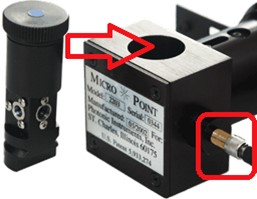
Figure 1 Dye laser assembly from left-to-right: dye cell resonator, dye cell block and N2 coupling fiber.
To couple the N2 pump laser with the dye laser, a UV transmitting optical fiber is used. In Figure 1 the optical fiber is shown highlighted on the right-hand side of the dye cell block. The dye cell resonator is installed into the block (Figure 1 shown by arrow) and secured. The dye laser thus assembled is pumped by focused 337 nm pulses resulting in emission of the selected dye wavelength as a near parallel beam. The dye laser beam is expanded and delivered via steering optics into the microscope where, after focusing, it presents a near diffraction limited spot in the specimen plane.
Two of the dye cell resonators are tuned to emission wavelengths 365 and 435 nm respectively, while the third “ALL” type is used for all other wavelengths.
The dye cells can be switched as user requirements for photo-stimulation change and so provide a very flexible tool. At high energies, MicroPoint can be used for ablation and cutting/marking, while at lower powers it is used for uncaging, bleaching and localized activation applications. The energy is modulated with a motorized neutral density filter over a range of three decades (orders of magnitude). Importantly the device can be adapted to a wide range of upright and inverted microscopes from all major manufacturers. This flexibility, range of wavelengths, energy and ease of configuration ensures that the MicroPoint finds widespread use in life sciences as well as industrial marking applications.
The Manual variant of MicroPoint has a fixed beam delivery system, with manual centering and focusing. In this mode, the specimen region of interest is positioned by XY stage and focus, at the location where the incident beam will be projected when triggered. Foot pedal, mouse or programmatic triggering is available.
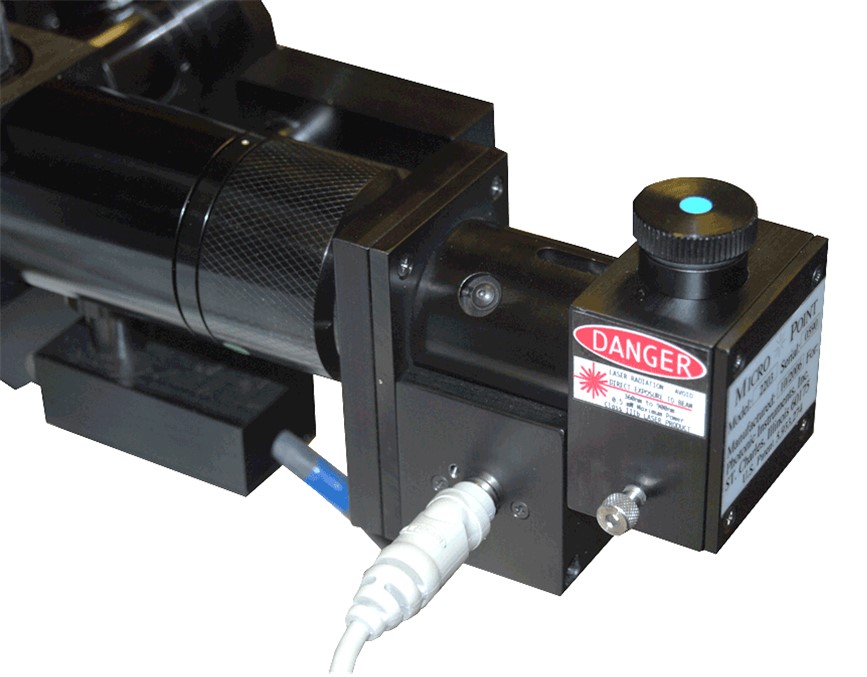
Figure 2 MicroPoint galvanometer model: motorized attenuator shown in front of the dye cell block.
The galvanometer version of MicroPoint allows the focal spot to be steered in the field of view over an area of approximately 7 x 7 mm when referenced to the primary image plane. This corresponds to an area slightly larger than the central quadrant of Andor cameras, including iXon Ultra 888, Sona 4B6 and or Zyla 4.2 plus. Galvanometer movements can be synchronized with laser pulses to allow photo-stimulation of regions or boundaries, or interactive tracking of moving features.
For more information see: http://www.andor.com/microscopy-systems/photostimulation/micropoint
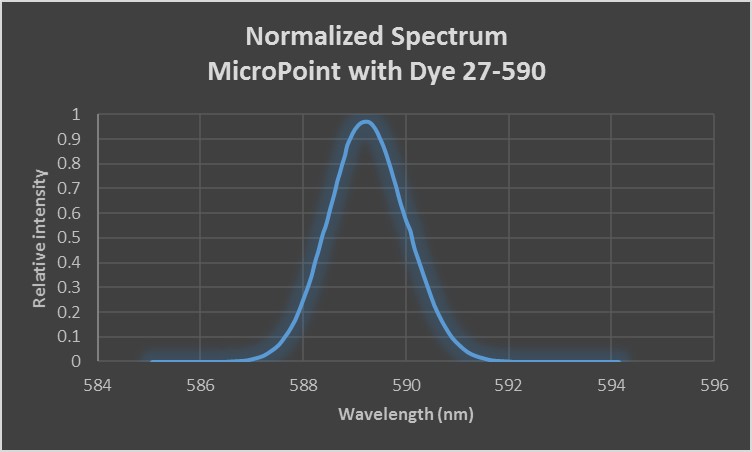
Figure 3 Typical emission spectrum of MicroPoint with Dye 27-590, showing Gaussian profile and typical 2nm bandwidth of dye-filled cavity resonator.
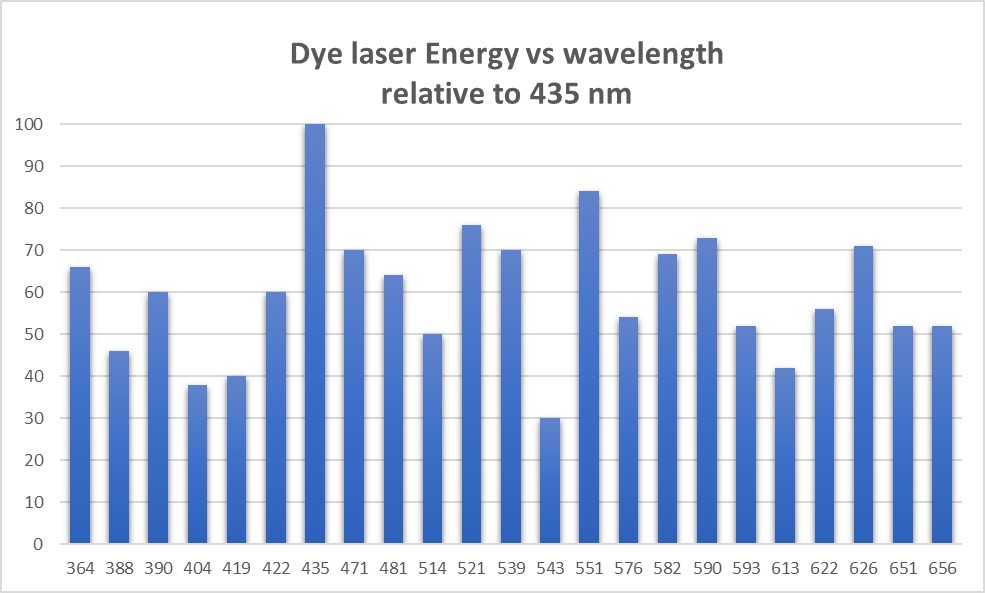
Figure 4 Relative energy plot for all dye laser wavelengths, referenced to 435 nm emission.
The Nitrogen (N2) pump laser provides 3.5 ns pulses at 337 nm (UV), with repetition rates up to 20 Hz. The pulse energy is 170 µJ, which results in a peak power of 45 kW and an average power of 3 mW. Triggering can be controlled internally or externally at rates up to 20 Hz. The N2 laser uses a replaceable, sealed laser cartridge which includes the high voltage storage capacitors, switching element, and laser tube. The cartridge is warranted to maintain at least 70 % of its energy for twenty million pulses or one year, whichever occurs first. No mirror alignment is ever necessary, as the laser optics are mounted on the plasma tube and aligned at the factory. The N2 laser includes all safety features necessary to comply with the U.S. laser safety standards contained in 21 CFR 1040.10 and IEC 60825-1.
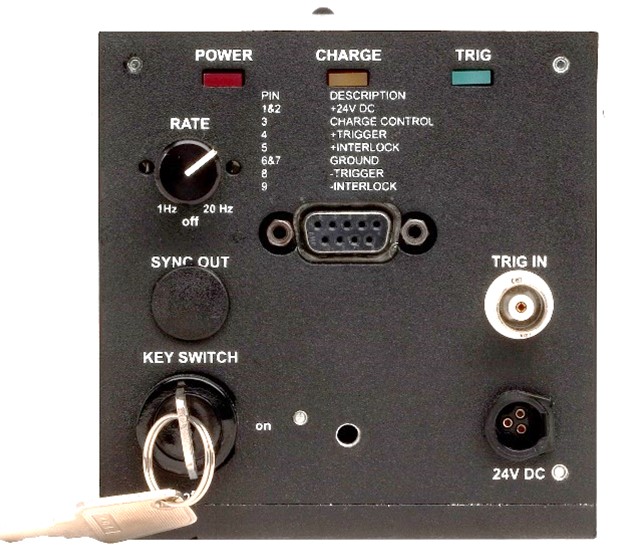
Wavelength 337.1 nm. Spectral bandwidth 0.1 nm. Pulse width (FWHM) < 3.5 ns. Pulse energy 170 µJ. Energy stability (pulse to pulse) 3 % std. dev. @ 10 Hz. Peak power 45 kW, Avg power 3 mW @ 20 Hz.
Wavelength 365 – 656 nm: 24 bands. Spectral bandwidth 2 t0 3 nm. Pulse width (FWHM) < 4 ns.
Pulse energy – wavelength dependent - max 12-40 µJ.
Energy stability (pulse to pulse) 4 % std. dev. @ 10 Hz. Peak power 10 kW, Avg power 800 µW @ 20 Hz.
Repetition rate 0 to 20 Hz (external trigger), 1 to 20 Hz (internal trigger).
External trigger input TTL (opto-isolated). Internal trigger generator1 to 20 Hz (adjustable)
Power requirements: +24 VDC, 1.5 A (average) at 20 Hz., 3 A (peak) Power consumption 36 W (20 Hz operation). Operating temperature < 35 °C. Key switch On/Off Interlock switch built-in.
Dimensions: 3.75" × 3.75" × 11" (WHL), (9.5 cm × 9.5 cm × 27.9 cm). Weight7.5 lbs., 3.4 kg Warranty: Cartridge is warranted to maintain at least 70 % of its energy for twenty million pulses or one year, whichever occurs first.
Date: October 2021
Author: Dr Mark Browne
Category: Application Note
